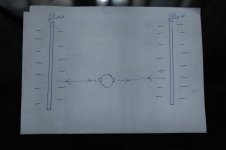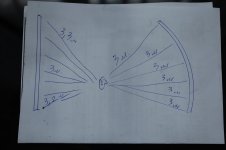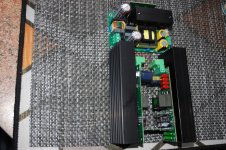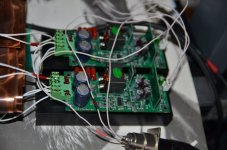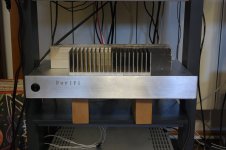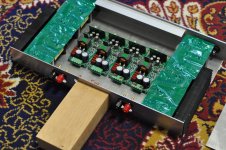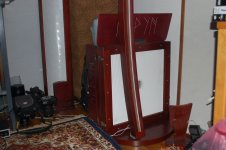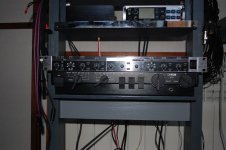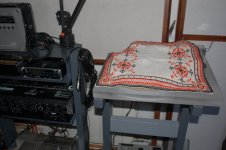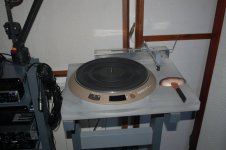I would also expect some effect in the horizontal plane?
For instance take take two points on the arc: A on the half height and B at the top end.
If you are right in front of the speaker at radius distance,the distance to A would be equal to B so it would nicely add up.
But now lets move 1 meter to the right while staying at radius distance of point A.
Now the distance to B would increase and A and B would not add coherently anymore.
For instance take take two points on the arc: A on the half height and B at the top end.
If you are right in front of the speaker at radius distance,the distance to A would be equal to B so it would nicely add up.
But now lets move 1 meter to the right while staying at radius distance of point A.
Now the distance to B would increase and A and B would not add coherently anymore.
To be honest, I don’t understand why we constantly move while listening to music?
Usually, the audio file lair is arranged in such a way that in the room there are acoustic systems strictly built in their location, an armchair on which we sit with outstretched legs, and a glass of wine on the right side😀.
Usually, the audio file lair is arranged in such a way that in the room there are acoustic systems strictly built in their location, an armchair on which we sit with outstretched legs, and a glass of wine on the right side😀.
I remember one case when my friend and I went to another city in order to listen to Klipsch horn speakers in a room of 100m2.
The point was that usually horn speakers are listened to in a much smaller room and there the horns do not work at full capacity, that is, there is not enough distance for the horn to work correctly.
So, in this room there was only one single chair for the listener, all the other guys just stood nearby and waited in line to listen, sitting on this chair it was impossible to deviate either to the right or to the left by 10 cm, because the stereo effect instantly collapsed, just like if you tilt your head forward by 10 cm, then the stereo scene falls to the floor, and if you tilt your head back by 10 cm, then the stereo scene rises to the ceiling.
But!, but in the "sweet spot" the sound was amazing and it was worth it to sit still and listen.
So in my case, in comparison with this, complete freedom, the only thing that is not desirable is to do physical exercises with squatting and standing up while listening to the Symphonies of Tchaikovsky or Mahler 🙂.
The point was that usually horn speakers are listened to in a much smaller room and there the horns do not work at full capacity, that is, there is not enough distance for the horn to work correctly.
So, in this room there was only one single chair for the listener, all the other guys just stood nearby and waited in line to listen, sitting on this chair it was impossible to deviate either to the right or to the left by 10 cm, because the stereo effect instantly collapsed, just like if you tilt your head forward by 10 cm, then the stereo scene falls to the floor, and if you tilt your head back by 10 cm, then the stereo scene rises to the ceiling.
But!, but in the "sweet spot" the sound was amazing and it was worth it to sit still and listen.
So in my case, in comparison with this, complete freedom, the only thing that is not desirable is to do physical exercises with squatting and standing up while listening to the Symphonies of Tchaikovsky or Mahler 🙂.
I drew a very rough picture of how this high-frequency emitter works, that is, in the horizontal plane you can move to the right and left, high frequencies up to 17 kHz will be across the entire width between the speakers and a distance of 3 meters from the speakers.I would also expect some effect in the horizontal plane?
For instance take take two points on the arc: A on the half height and B at the top end.
If you are right in front of the speaker at radius distance,the distance to A would be equal to B so it would nicely add up.
But now lets move 1 meter to the right while staying at radius distance of point A.
Now the distance to B would increase and A and B would not add coherently anymore.
But in the vertical plane, high frequencies will be grouped at one point, but the quality of high frequencies will be the highest, because there will be no delay in the time they arrive at the listener's ear.
Attachments
But again... when you move horizontally also the distances will not be constant any more, please re-read my example.
The effect will not be as dramatic as moving vertically but it is there.. Maybe I should make a real calculation to see how big the effect would be..
The effect will not be as dramatic as moving vertically but it is there.. Maybe I should make a real calculation to see how big the effect would be..
If you want to move around while listening, you should consider mono.
Stereo doesn't involve moving around in the listener's space at all.
It concerns not only my speakers, but also any others, if you will not be in the center between the speakers and the angle will be different than 60 degrees, the stereo effect will be broken and in this case will be preferable to mono, as well as radiators in the middle and high frequencies of such speakers (mono) are preferable in the form of a dome.
But if you want to get everything possible from the stereo, the radiators, especially the midrange and treble should be grouped and made as much as possible directed to the listener.
It's my personal opinion, but there are also other opinions, for example, that it is necessary to dissipate sound as much as possible🙂.
As for your remarks about the change of high frequencies when moving in a horizontal plane,I can try a microphone, move it to the right and left and take a video.
Stereo doesn't involve moving around in the listener's space at all.
It concerns not only my speakers, but also any others, if you will not be in the center between the speakers and the angle will be different than 60 degrees, the stereo effect will be broken and in this case will be preferable to mono, as well as radiators in the middle and high frequencies of such speakers (mono) are preferable in the form of a dome.
But if you want to get everything possible from the stereo, the radiators, especially the midrange and treble should be grouped and made as much as possible directed to the listener.
It's my personal opinion, but there are also other opinions, for example, that it is necessary to dissipate sound as much as possible🙂.
As for your remarks about the change of high frequencies when moving in a horizontal plane,I can try a microphone, move it to the right and left and take a video.
Last edited:
I bought two monoblocks of Class D amplifiers based on Purifi circuitry.
Made in Ukraine in Ivano-Frankivsk.
I will try, I do not know where else, if it proves itself well at high frequencies, then I will apply there, but if it loses class "A" amplifier Tonevin, then I will apply in the low-frequency register.
Made in Ukraine in Ivano-Frankivsk.
I will try, I do not know where else, if it proves itself well at high frequencies, then I will apply there, but if it loses class "A" amplifier Tonevin, then I will apply in the low-frequency register.
Attachments
In general, I temporarily connected this amplifier (Purifi) to the high-frequency unit.
The sound exceeded all my expectations, extremely smooth.
I ordered another such amplifier on the low-frequency unit, later I will make a single case for two amplifiers and think about how to organize cooling of amplifier transistors, as well as transistors of power supplies, in advance I think they will be attached to one top cover of aluminum thickness of 2 mm, which will be connected to the other aluminum parts of the case through thermal paste and thus the whole case will be a kind of radiator for cooling.
The sound exceeded all my expectations, extremely smooth.
I ordered another such amplifier on the low-frequency unit, later I will make a single case for two amplifiers and think about how to organize cooling of amplifier transistors, as well as transistors of power supplies, in advance I think they will be attached to one top cover of aluminum thickness of 2 mm, which will be connected to the other aluminum parts of the case through thermal paste and thus the whole case will be a kind of radiator for cooling.
Attachments
Amplifier Purifi was very high in sound quality, so I decided to take more seriously to make a case for it, the unexpected was that the cooling of transistors requires a sufficient area of heat sinks, it was a surprise to me compared to the same class "D" amplifier on the chip 3255, but the Holy Grail is caught and it will be implemented necessarily!
You mentioned they were no real Purifi but clones?
That explains the need for a heatsink.
I have a pair of original Purifi's in daily use, they are bolted to the bottom of a case and do not even get hand-warm.
It is misleading if not worse for you to call your amps 'Purifi'. They are not.
Jan
That explains the need for a heatsink.
I have a pair of original Purifi's in daily use, they are bolted to the bottom of a case and do not even get hand-warm.
It is misleading if not worse for you to call your amps 'Purifi'. They are not.
Jan
Last edited:
Thanks for responding to a rather specific topic like Purifi, yes, it's a clone, but it's quite well made.
The thing is that here in the thread we are talking about electrostatics, which means that I use the amplifier data at least 50% or even more, so the comparison in the heating of radiators can be quite different.
The thing is that here in the thread we are talking about electrostatics, which means that I use the amplifier data at least 50% or even more, so the comparison in the heating of radiators can be quite different.
The circuit topology and parts used are the same as those of PURIFY.
Ok, on the Diy Audio forum many people repeat the circuitry of different developers and labels.
I am not the manufacturer of these amplifiers, I am only a user and in order to designate what kind of circuitry we are considering in this case I did not hide that it is PURIFY.
If this word is unpleasant to your ears, then I can call it PUMAFA, it will be okay?
Ok, on the Diy Audio forum many people repeat the circuitry of different developers and labels.
I am not the manufacturer of these amplifiers, I am only a user and in order to designate what kind of circuitry we are considering in this case I did not hide that it is PURIFY.
If this word is unpleasant to your ears, then I can call it PUMAFA, it will be okay?
This I will remake, as you can see-4 amplifier modules and four power supplies channel by channel, each module is a stereo channel, that is, two amplifiers with mono-blocks of the amplifier part, as well as power supplies.
The low-frequency part is connected directly from the Canton preamplifier, and the high-frequency part is connected through an active crossover, with a cutoff of 600Hz.
So, this amount of heat sinks is enough to work two amplifiers, each in its own band.
Given that the load in the form of electrostatics,that is a very complex load for amplifiers,then this number of radiators is normal.I think so.
Of course if it were regular speakers with 98dB sensitivity, this amplifier would work with a load of only 5-10%, but in my case the load is 50%, so the heat of the parts that need to dissipate on the radiators will be much higher.
This version of the photo is a draft, I made a mistake with the heat dissipation, I came up with another version of the amplifier housing, it will be better.
Nothing works from the first time, but only from the second, or even the third.But this is normal and I know it.
The low-frequency part is connected directly from the Canton preamplifier, and the high-frequency part is connected through an active crossover, with a cutoff of 600Hz.
So, this amount of heat sinks is enough to work two amplifiers, each in its own band.
Given that the load in the form of electrostatics,that is a very complex load for amplifiers,then this number of radiators is normal.I think so.
Of course if it were regular speakers with 98dB sensitivity, this amplifier would work with a load of only 5-10%, but in my case the load is 50%, so the heat of the parts that need to dissipate on the radiators will be much higher.
This version of the photo is a draft, I made a mistake with the heat dissipation, I came up with another version of the amplifier housing, it will be better.
Nothing works from the first time, but only from the second, or even the third.But this is normal and I know it.
Attachments
Doing ****:
The video heads are completely disconnected so the video doesn't interfere with the audio.
The video heads are completely disconnected so the video doesn't interfere with the audio.
Really? So Purifi send you their schematics? They also sent you their PCBs? It's not a matter of unpleasant to ears, it is dishonest to use somebody else's name in order to make your own stuff look better.The circuit topology and parts used are the same as those of PURIFY.
Ok, on the Diy Audio forum many people repeat the circuitry of different developers and labels.
I am not the manufacturer of these amplifiers, I am only a user and in order to designate what kind of circuitry we are considering in this case I did not hide that it is PURIFY.
If this word is unpleasant to your ears, then I can call it PUMAFA, it will be okay?
Jan
- Home
- Loudspeakers
- Planars & Exotics
- Full-range, two-way ESL
